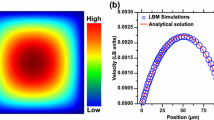Abstract
The transport properties of cement-based materials significantly affect their durability. This results from the fact that most of the damaging reagents are transported, often solved in water, through the open pore space into the microstructure. This paper focuses on simulating water permeation (movement under a gradient of pressure) and water vapor diffusion (movement under a gradient of concentration) through hardened cement paste (hcp). The main goal is to derive the water permeability and the water vapor diffusion coefficient directly from the morphology of the 3D microstructure. For this purpose microtomographic images of a hcp made of ordinary Portland cement are used to represent the microstructure and especially the pore space through which the moisture transport will occur. With the use of a skeletonization algorithm, also known as “thinning algorithm”, the skeleton or centerline of the pore space is extracted. This skeleton is in a second step converted into a transportation network of cylindrical tubes. Bernoulli's law is applied to every tube for simulating water permeation. The permeability coefficient is then calculated by using Darcy's law. In the case of water vapor diffusion the diffusion coefficient is calculated using Fick's law.
Similar content being viewed by others
References
Bentz DP et al. (2002) The Visible Cement Data Set. J. of Research of the National Institute of Standards and Technology 107:137–148
Carman PC (1937) Fluid Flow Through Granular Beds. Trans Inst Chem Eng 15:150
Carman PC (1938) The Determination of the Specific Surface of Powders. J Soc Chem Industries 57:225
Daian JF, Xu K, Quenard DA (1994) Invasion and Transport Processes in Multiscale Model Structures for Porous Media. Amsterdam : Elsevier, 1994. Characterization of Porous Solids: Proc IUPAC Symposium (COPS III), Marseille, France, May 9–12, (Rouquerol J et al. (ed.)), 187–196
Daian JF, Xu K, Quenard DA (1996) Multiscale Models: A Tool to Describe the Porosity of Cement-Based Materials and to Predict their Transport Properties. Dordrecht: Kluwer Academic Publishers, 1996. The Modeling of Microstructure and its Potential for Studying Transport Properties and Durability, (Jennings H, Kropp J, Scrivener K (eds.)), vol. 304, 107–136
Halamickova P et al. (1995) Water Permeability and Chloride Ion Diffusion in Portland Cement Mortars: Relationship to Sand Contend and Critical Pore Diameter. Cement and Concrete Research 25:790–802
Hedenblad G (1997) The Use of Mercury Intrusion Porosimetry or Helium Porosity to Predict the Moisture Transport Properties of Hardened Cement Paste. Adv Cement Based Mater 6:123–129
Hoshen J, Kopelman R (1976) Percolation and cluster distribution. I. Cluster multiple labeling technique and critical concentration algorithm. Phys Rev B 14:3438–3445
Hou X-J et al (1990) An Efficient Algorithm for Fast O(N*ln(N)) Box Counting. Phys Lett A 151:43–46
Katz AJ, Thompson AH (1986) Quantitative Prediction of Permeability in Porous Rock. Phys Rev B 34:8179–8181
Kong TY, Rosenfeld A (1989) Digital Topology: Introduction and Survey. Computer Vision, Graphics, and Image Processing 48:357–393
Kozeny J (1927) Über kapillare Leitung des Wassers im Boden. Royal Academy of Science, Vienna, Proc. Class I 136:271
Liang Z, Ioannidis MA, Chatzis I (2000) Permeability and Electrical Conductivity of Porous Media from 3D Stochastic Replicas of the Microstructure. Chem Eng Sci 55:5247–5262
Liang Z, Ioannidis MA, Chatzis I (2000) Geometric and Topological Analysis of Three-Dimensional Porous Media: Pore Space Partitioning Based on Morphological Skeletonization. J Colloid Interface Sci 221:13–24
Malandain G, Bertrand G (1992) Fast Characterization of 3D Simple Points. Los Alamitos, California : IEEE Computer Society Press, 1992. Proc IEEE Computer Society Conference on Computer Vision and Pattern Recognition, Champaign, Illinois, June 15–18, 232–235
Manwart C et al. (2002) Lattice-Boltzmann and finite-difference simulations for the permeability for three-dimensional porous media. Phys Rev E 66:1–11
Palágyi K et al. (2001) A Sequential 3D Thinning Algorithm and Its Medical Applications. Proc of the 17th International Conference on Information Processing in Medical Imaging, IPMI 2001, Davis, USA, June 18–22, 2001, (Insana MF, Leahy RM (eds.)), LNCS 2082, 409–415
Powers TC, Brownyard TL (1948) Studies of the physical properties of hardened Portland cement paste. Research Laboratories of the Portland Cement Association Bulletin 22:(March 1948)
Powers TC (1958) Structure and Physical Properties of Hardened Portland Cement Paste. In: Journal of the American Ceramic Society 41 (1958), No. 1, 1–6
Powers TC (1962) Physical properties of cement paste. Proc. Fourth Int Symp Chemistry of Cement, Washington, D.C., 1960, U.S. Department of Commerce, National Bureau of Standards, Monograph 43, vol. 2, 577–613
Quenard DA et al. (1998) Microstructure and Transport Properties of Porous Building Materials. Mater Struct (RILEM) 31:317–324
Quenard DA et al. (2000) Microstructure and Transport Properties of Porous Building Materials. II: Three-Dimensional X-Ray Tomographic Studies. Mater Struct (RILEM) 33:147–153
Rucker P (2004) Moisture and Salt Transport in Concrete - A New Approach to Modelling. Leiden : A.A. Balkema Publishers, 2004. 5th Int PhD Symposium in Civil Eng, Delft, 16 – 19 June 2004, (Walraven J, Blaauwendraad J, Scarpas T, Snijder B (ed.)), vol. 1, 111–118
Author information
Authors and Affiliations
Corresponding author
Additional information
An erratum to this article is available at http://dx.doi.org/10.1007/s00466-005-0738-6.
Rights and permissions
About this article
Cite this article
Koster, M., Hannawald, J. & Brameshuber, W. Simulation of water permeability and water vapor diffusion through hardened cement paste. Comput Mech 37, 163–172 (2006). https://doi.org/10.1007/s00466-005-0687-0
Received:
Accepted:
Published:
Issue Date:
DOI: https://doi.org/10.1007/s00466-005-0687-0




